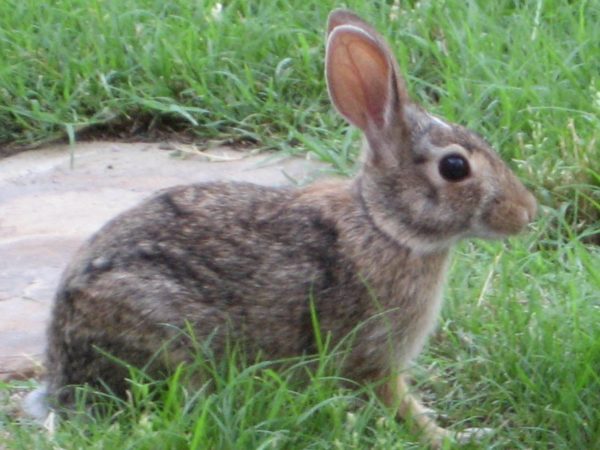Texas Backyard Critters

Exploring my backyard has replaced day trips, as we all do our part to stop the spread of covid-19 and stay home. I am amazed and entertained by the microcosm of life around me. One frequent visitor to my garden oasis, consistently maintains at least the CDC prescribed six-foot distance – an eastern cottontail rabbit my family named Hoppy. This little guy … could be a gal … it’s difficult to sex a rabbit … lives under a tool shed in the corner. The yard is fenced, offering Hoppy protection from most predators, though I’ve noted he’s beginning to foray out in the evenings. And while he does prefer to dine on black eyed susan plants, he’s discovered that seeds, dropped by squirrels raiding the bird feeder, are mighty tasty, too.
While many view the rabbit as a pest, I admire its adaptability. The eastern cottontail is ubiquitous adjusting to North Texas’ changing landscape and creating habitat for itself in among suburban subdivisions. On my neighborhood walks, I frequently spy at least one fluff-tailed critter. An herbivore, the rabbit dines on lawns and makes its home in shrubs. An opportunistic vegetarian, the eastern cottontail will gladly switch from its native diet of grasses to other garden plants, like my black eyed susan, when available.
These small mammals weigh just two to four pounds. They are crepuscular, meaning they’re active during dawn and dusk, generally resting during the day. I often find Hoppy catching a little afternoon sun and taking a nap nestled in the garden bed mulch.
In the wild, rabbits live just a little over a year contending with predators like bobcat, fox, coyote, owls, and hawks. To survive, cottontails possess exceptional eyesight and hearing. If they sense danger, the rabbit will freeze in place or dash for cover. Backyard naturalists likely have seen both behaviors. Cottontails can jump up to 15 feet and often will flee in a zigzag pattern – done to throw a predator off its scent.
Life is tough for the eastern cottontail, even in suburbia. Backyard bunnies, like Hoppy, have to contend with predatory dogs and cats, but most are killed by cars. Still, rabbits thrive in North Texas often birthing several litters of kits each season. Unlike their cousin the hare, rabbits are helpless at birth, born both blind and hairless. The new kit (baby rabbit) will quickly grow its fur and open its eyes, leaving the nest within about two weeks. Kits mature to full grown adults within four or five months. I’ve watched Hoppy grow from small kit to full grown rabbit over the past several months. He continues to captivate me with his cuteness.
More Rabbit Tidbits
- Eastern cottontails are not social animals and prefer to live singularly.
- The female cottontail is larger than the male.
- Cottontails rarely drink water, getting most of their water from the plants they eat.
- In winter, if green plants are not available, the cottontail will eat twigs and bark.
- Cottontails will sometimes eat their own droppings to get all the nutrients from the food they ate.

